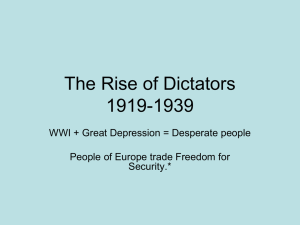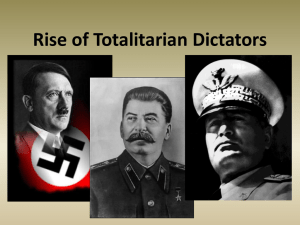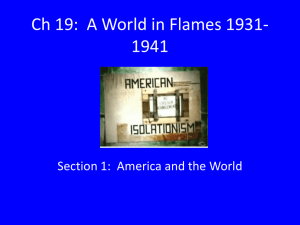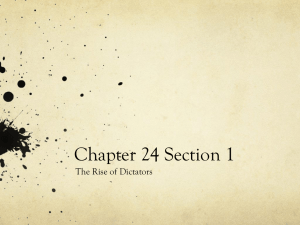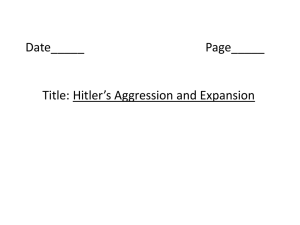Chapter 31_ Section 3
advertisement
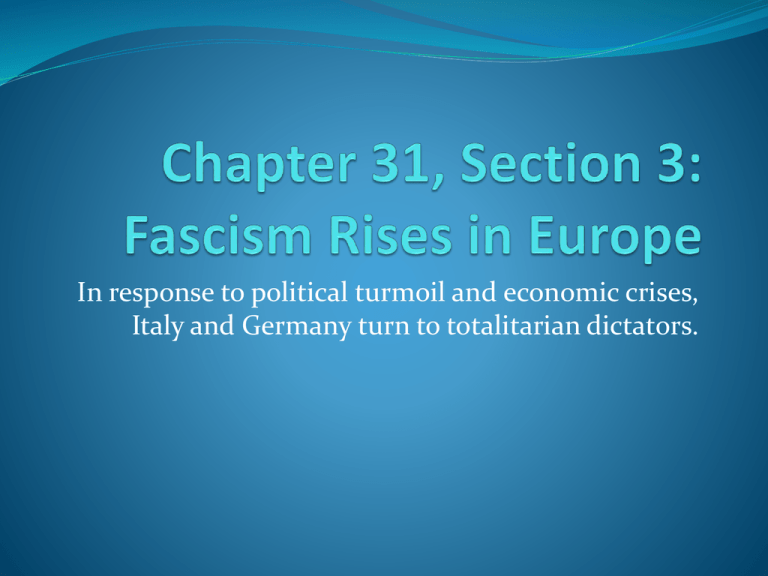
In response to political turmoil and economic crises, Italy and Germany turn to totalitarian dictators. Fascism’s Rise in Italy New Political Movement Fascism is new, militant political movement. Emphasizes nationalism and loyalty to authoritarian leader. Mussolini Takes Control Italians want a leader who will take action Fascist party leader, Benito Mussolini, promises to rescue Italy Italian king puts Mussolini in charge of gov’t. Il Duce’s Leadership Mussolini takes firm control of politics and economy in Italy Hitler Rises to Power in Germany A New Power Adolf Hitler-little known political figure in 1920s Germany The Rise of the Nazis Nazism-German brand of fascism Hitler becomes Nazi leader, plots to seize national power Mein Kampf-Hitler’s book detailing beliefs, goals Hitler believes that Germany needs lebensraum, or living space Germans turn to Hitler when economy collapses Hitler Becomes Chancellor Hitler’s New Power Hitler is named chancellor Turns Germany into a totalitarian state Uses brutal tactics to eliminate enemies Nazis take command of economy The Fuhrer is Supreme Hitler takes control over every aspect of German life Hitler Makes War on the Jews Nazis deprive Jews of rights, promote violence against them Other Countries Fall to Dictators World is Divided Most of Eastern Europe falls to dictators Only Czechoslovakia retains democratic government World splits into two camps-democratic and totalitarian As Germany , Italy and Japan conquer other countries, the rest of the world does nothing to stop them. Japan Seeks an Empire Militarists Take Control of Japan Military leaders take control of country Want to solve economic problems through foreign expansion Japan Invades Manchuria Japan has investments in Manchuria, Chinese province In 1931, Japanese army seizes Manchuria League of Nations protests action; Japan withdraws from League Japan Seeks an Empire Japan Invades China In 1937, Japan launches war on China European Aggressors on the March Mussolini Attacks Ethiopia In 1935, Mussolini attacks Ethiopia League of Nations does not stop aggression Hitler Defies Versailles Treaty In 1935, Hitler begins rebuilding German army In 1936, Germany occupies Rhineland (a 30-mile wide buffer between France and Germany) Britain urges appeasement, a policy of giving in to aggression Germany, Italy, and Japan-the Axis Powers-form an alliance European Aggressors on the March Civil War Erupts in Spain In 1931, a republic is declared in Spain In 1936, General Francisco Franco leads rebellion Hitler and Mussolini help Franco and his fascists In 1939, Franco wins Spanish Civil War Franco becomes Spain’s Fascist dictator Democratic Nations Try to Preserve Peace United States Follows an Isolationist Policy Isolationism-avoidance of political ties with other countries In 1935, Congress passes Neutrality Acts (bans loans and arms sales to nations at war) The German Reich Expands Hitler plans to expand Third Reich-German Empire In 1938, Hitler annexes Austria Hitler demands the Sudetenland from Czechoslovakia Czechs refuse, ask France for help Democratic Nations Try to Preserve Peace Britain and France Again Choose Appeasement Leaders meet at Munich Conference to settle Czech crisis Britain and France agree to let Hitler take Sudetenland But in 1939, Hitler still takes the rest of Czechoslovakia Mussolini takes Albania; Hitler demands parts of Poland Democratic Nations Try to Preserve Peace Nazis and Soviets Sign Nonaggression Pact In 1939, Stalin and Hitler pledge never to attack one another




